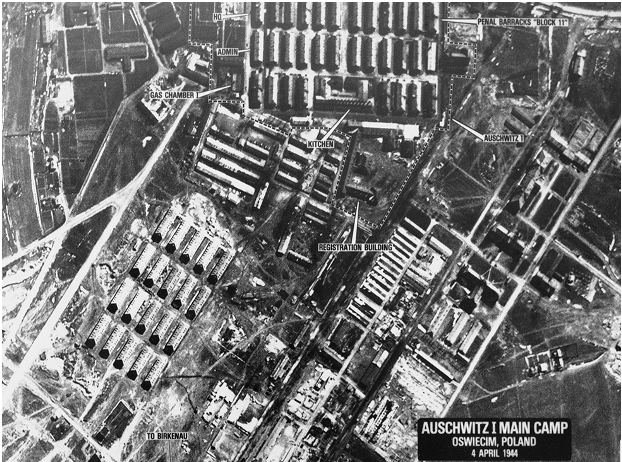What You See from Here You (Don’t) See from There
Keren Ben-Hagai
I would like to put two images from the history of the Jewish people side by side. Different epochs, different gaze.
I. The first image is from Harun Farocki’s film, Bilder der Welt und Inschrift des Krieges.[1] The film highlights something of the idea of the split between the eye and the gaze that Lacan explains to us in Seminar XI.[2] There is an image that repeats over and over in the film stating the following: “An American pilot clicked his camera shutter and took photographs of the Auschwitz concentration camp... The pictures taken in April 1944 arrived for evaluation. The analysts discovered a power station, a carbide factory, a factory under construction and another for petrol hydronation. They were not under orders to look for the Auschwitz camp, and thus they did not find it.”[3]
To our astonishment, we learn that the story about the photo was discovered only in 1977. How can this be understood? We can say that the eye sees through historical-cultural filters. It is connected with the imaginary dimension that covers the holes, closes them up or skips over them, in a manner of a screen over the recognition of possible horror. What we might discover with the gaze is related to the refusal to see the atrocities that took place in those buildings. Does this stem from the order of negation?
II. The second image comes from the body cameras of the terrorists who invaded the Kibbutzim and villages along the Gaza border. It is one of the numerous photos that made up the footage of the “horror movie” documenting the events of October 7 in Israel. The full horror is presented to the viewer. It is the real without any masking, without any curtain to hide even a little what is unbearable to see. Deep anguish.
This set of images can be read in a similar way to how Lacan reads the father’s dream of the burning child – it “shows” as opposed to sees.[4] He adds that our position in the dream is fundamentally that of someone who does not see. The subject does not see where it leads, he follows. “It shows” (le donner-a-voir) for Lacan is the essence of the gaze, detached from the other. It can be suggested that the images of the atrocities function for the viewer as a stain where the point of tyche in the scopic function is found – in other words, the vanishing point of being. Lacan associates the gaze with a freezing of movement.[5] Is it possible, therefore, to understand the compulsion to look at those images through fascination?[6]
Two images, two epochs
One of them highlights something from the order of “not wanting to know,” of repression. It is related to what Jacques-Alain Miller refers to as the Victorian era, which revolves around the Name-of-the-Father.[7] This is Freud’s epoch – which can be said to be characterized by phallic logic and the discontent manifested in modalities of neurotic symptoms – the “elision” of Auschwitz in the eyes of the photo analysts, for example. The object little a is linked to castration and removed from the image.
The set of images from the current epoch demonstrate how object little a is pushed to the front of the stage, and is no longer articulated to minus phi. It is the horror as such, visible to the bone, transmitted to all through social media. Éric Marty reads this as “the destruction of all language,” as a Sadean act, which is not based on philosophy or political theory but on the performativity of the image as such.[8] This rise to the zenith of the object little a remains the subject of the epoch, forsaken and looking for a compass.[9]
References
[1] Farocki, H., Bilder der Welt und Inschrift des Krieges [Images of the World and the Inscription of War], Germany, 1988.
[2] Cf. Lacan, J., The Seminar of Jacques Lacan, Book XI: The Four Fundamental Concepts of Psychoanalysis, ed. J.-A. Miller, trans. A. Sheridan, New York/London: Norton, 1977.
[3] Farocki, H., Bilder der Welt und Inschrift des Krieges, op. cit.
[4] Lacan, J., The Seminar of Jacques Lacan, Book XI: The Four Fundamental Concepts of Psychoanalysis, op. cit., p. 75.
[5] Ibid., p. 117.
[6] The evil eye, fascinum.
[7] Miller, J.-A., “Milanese Intuitions,” Paradigms of Jouissance, Psychoanalytical Notebooks 34, 2019, p. 94.
[8] Cf. Marty, É., “Avec l’agression barbare du 7 octobre, le Hamas a rejoint le paradigme inauguré par Al-Qaida, affermi et consolidé par l’État islamique,” Le Monde, 19/10/2023.
[9] Cf. Miller, J.-A., “A Fantasy,” IV Congress of the WAP, Comandatuba, Bahia, Brazil, 2004.


